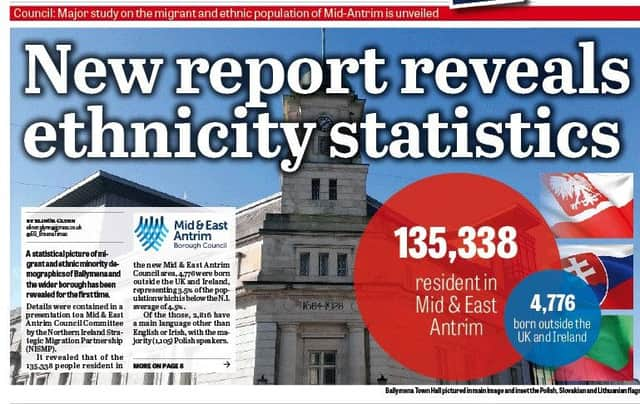Report reveals diversity and size of local ethnic population


Details were contained in a presentation to a Mid & East Antrim Council Committee at its meeting in Ballymena last Tuesday night by the Northern Ireland Strategic Migration Partnership (NISMP).
It was suggested by the NISMP’s Board that new ‘super authorities’ be offered a presentation on their specitic community profile produced in conjunction with the NI Local Government Association, on the Partnership’s work, and the support it can offer.
Advertisement
Hide AdAdvertisement
Hide AdLocal government reform has coincided with a significant demographic change in Northern Ireland brought about by almost 10 years of inward migration.
In the 2011 census 4.5% of the population were born outside the UK or Ireland, representing a three per cent rise in resident migrants in just a decade.
It revealed that of the 135,338 people resident in the new Mid & East Antrim Council area, 4,776 were born outside the UK and Ireland, representing 3.5% of the population which is below the N.I. average of 4.5%.
Of those, 2,816 have a main language other than English or Irish, with the majority (1,105) Polish speakers followed by 78 (Lithuanian), 35 (Gaelic/Irish), 70 (Portuguese), 365 (Slovak), 101 (Chinese), 59 (Tagalog/Filipino), 46 (Latvian), 32 (Russian), 52 Malayalam), 12 (Hungarian) and 896 (other).
Advertisement
Hide AdAdvertisement
Hide AdOf those whose main language is not English or Irish, 31% cannot speak English or cannot speak it well, according to the statistics.
During 2007, when the most recent inward migration trend peaked, 1,112 health card registrations from non-UK nationals were made in Ballymena, Carrickfergus and Larne Councils which, against 417 deregistrations, represented a net increase of 695.
Data configured for the 11 new local government districts (LGD), also shows that in 2013 the top three countries of birth for non UK-born health card registrations in Mid & East Antrim were Poland, Romania and Slovakia with the top two reasons given for coming to NI being work (59%) and family (27%).
In 2012, 310 National Insurance Numbers were allocated to non UK residents in Ballymena, compared to 60 in Carrick and 30 in Larne and the data showed that since 2003, Ballymena has had a consistently higher number of NINo allocations than either Larne or Carrick with a peak of 830 allocations in 2006.
Advertisement
Hide AdAdvertisement
Hide AdThe number of requests for interpreter services from the Northern Health and Social Care Trust has grown steadily from 3,862 in 2006-2007 to 10,987 in 2013-2014. There has also been an increase - of 135%, between 2007 and 2013, in the number of newcomer pupils (those without satisfactory language skills) enrolled in schools within the three council areas.
Regarding economically active residents ie those either employed or actively seeking employment aged 16-74 (according to their main spoken language), the highest percentage in Ballymena are Slovakian (93%), followed closely by Latvian and Malayalam (92%), Tagalog/Filipino (89%), Polish (87%), Lithuanian and Russian (85%), Hungarian (80%), Irish (78.5%), Portuguese (78%), English (68%), Chinese (64%).